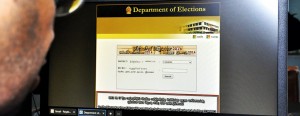Updating to Windows 10 on July 29, yes or no?
Sri Lankans join an estimated 1 billion people from virtually every country of the world and every walk of life in eager anticipation of Wednesday’s (July 29) launch of Windows 10, the latest version of Microsoft’s still dominant PC-based operating syste (OS). While the PC is said to be dying, allegedly being replaced by increasing demand for phones and tablets, fan frenzy for Windows 10 is undoubtedly at its greatest heights. Thanks in no small part to an unprecedented free upgrade offer from Microsoft, which is actually only free of charge for current users of Windows 8.1 and Windows 7.

An interested party checks whether they are registered to vote at the upcoming, August 17 Parlimentary Elections using the Department of Elections website (http://www.slelections.gov.lk/ID/index.aspx}.
However, industry watchers are foretelling bad omens for Windows 10′s debut this Wednesday, with expectations that servers will crash under the weight of too many downloads, as well as the always recurring hardware and software issues that have become haunted Windows upgrades in the past. Adding to these concerns are media statements that Windows 10 will only work with higher specs (a 1 GHz processor, 1 GB RAM, 16 GB storage, and a minimum.
1,024 x 600 resolution), a problem for some Windows 7 users that currently use lower spec machines, even despite previews indicating that the new OS is actually more akin to a Windows 8.1 update, a 8.2 as it were, instead of a true paradigm-breaking game changer.
There are also a number of other very real issues that could potentially crop up, based on already online previews of Windows 10 developer versions having made their way online since news of this vista of Windows was first announced on January 21, 2015, with its release date later emerging on June 1, 2015.
Online chatter has mainly, angrily buzzed about the expected obsolescence of familiar applications such as Windows Media Centre and some games, as well as even Windows 7′s desktop widgets, while, importantly for those still dependent on some type of legacy back-up system, it has been noted that there will no longer be support for floppy disks. Additionally, Microsoft has also revealed that watching DVDs will require setting up “separate playback software”, causing further griping. But more worry for others is that a number of these so-called shiny new Windows 10 gadgets that Microsoft has frequently promoted will be highly limited in first stage deployments. For example, Cortana will only be available in the US, Canada, UK, China, France, Italy, Germany, and Spain when launched, while the biometric password functionality of Windows Hello will require an infrared camera for facial recognition, or a supported fingerprint reader.
This is, of course, aside from a number of unexpected glitches that typically arise during run-of-the-mill Windows updates, which have become known for breaking software drivers willy-nilly, among other things, with fixes only available much later on, vi automatic updates. So much so that many are advising those that are interested in the Windows 10 upgrade to wait about a month or more, so that major issues are resolved prior to us laymen downloading and installing Windows 10.
Above all, considering the Sri Lankan context, where pirated software is prevalent, it must be kept in mind that, despite being one of the few OS’s that still requires a purchase for enhanced functionality (Windows 10 Pro is expected to go on sale for US$ 199), while OS’s Apple, Linux, etc. come free; there is still a lot of confusion about how the Windows 10 free upgrade will affect the vaguely-termed “non-genuine users”, or users running pirated copies of Windows 7 and 8.1, often through no fault of their own, which Microsoft has already stated will be able to upgrade to the new Windows 10 version free of charge.
On the other hand, some industry watchers have also issued a caution, speculating that Microsoft, which is notoriously anti-software piracy, having taken a leading role in raids on companies using non licensed software in the past; could be actually deploying one of two strategies with the ultimate goal being an universal deployment of Windows 10, what it once publicly touted as being the “last version of Windows ever”, which in turn has set up further conjecture that this version is a placeholder for a whole new OS and marketing strategy.
The reasoning behind the free Windows 10 “non-genuine users” upgrade is being speculated as thus, either it is a plan to attract new users by offering them better features, etc and then up-sell them with apps, etc similar to what Apple has done successfully for years; or, it’s a trap of epic proportions, getting “non-genuine users” to upgrade and, after a trial period, making them privy to an automatic update that blocks all Microsoft software that does not have valid, yearly updated activation codes, which may fit with Microsoft’s past track record also.
While many suggest that the Windows 10 is actually a free giveaway, in the spirit of welcoming users, both legit and “non-genuine”, to a so-called new age of multi-device cross-functionality, those putting forward the alternative hypothesis, that the Windows 10 upgrade is actually a “bait and switch”, have also gathered significant traction, especially since one glaring line in the new upgrade’s terms and conditions, oft-quoted by now, states that the Windows 10 Home edition upgrade users will no longer be able to opt out of, or defer, automatic updates. But the true scope of this statement, and what it means ultimately, will only ring true following the July 29 launch.So the best advice anyone can give about Windows 10, like in so many other situations in life, is wait and see.


